Reviews by Team: Bundle for Racial Justice and Equality
Reviewing the largest indie bundle in history
Highway Blossoms is a romantic visual novel about two young women (Amber and Marina) who meet through a chance encounter on the side of the road, and soon embark on an adventure together. It is a 4-6 hour long story told in text, pictures, animations, music, sound and voice. As the player, you don’t get to make any choices—your influence ends on the settings screen.
The story is told in the first person from the perspective of Amber, who is on a road trip in her grandfather’s RV. Her grandfather, who played a central role in Amber’s life, has recently passed away, and the trip is Amber’s way to process the loss. In this healing journey, she is aided by a bucket full of cassette tapes that she and “gramps” used to listen to.
On the side of the road in New Mexico, Amber first spots Marina, whose car appears to have broken down, and offers her assistance. It turns out that Marina is bubbly, cheerful, and entirely unprepared for her first trip away from home.
Soon enough, Marina draws a reluctant Amber into the purpose of her own trip: a treasure hunt across multiple states, based on claims in an old journal ostensibly written by a gold rush era miner.
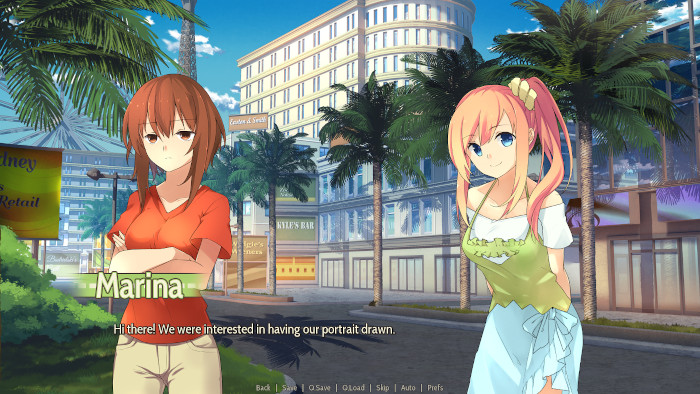
Amber and Marina in Vegas. These are the two sprites (with different facial expressions, poses and gestures) used through most of the game. (Credit: Studio Élan. Fair use.)
Amber and Marina grow closer during their adventure, and their blossoming love is the fluttering heart of the story. They do encounter other characters, chief among them a trio of treasure hunters led by a fierce and obnoxious woman named Mariah.
Tropes in America
In many ways, it feels more apt to compare Highway Blossoms with a romantic comedy movie than with a novel. The characterizations are over-the-top (Marina is the ditzy but angelic love interest sometimes found in rom-coms), and the presentation heavily relies on the capable voice acting by Katie Dagnen (Amber) and Jill Harris (Marina).
It’s all very cheesy, but it works, and you quickly forget that you’re not at the wheel at any point during this trip. The story features many notable sites—e.g., Shiprock, Canyon de Chelly, Arches National Park—which may inspire some players to make real world travel plans. The treasure hunt that motivates several of the stops gives parts of the story an unfortunate colonialist undertone.
The game features two erotic scenes between the main characters, which can be downloaded from the game’s website and added to censored editions. The scenes are part of the story and their inclusion feels neither forced nor gratuitous. In addition, the game includes extras such as “Marina’s Thoughts”, a gallery of small mementos from the story with Marina’s written comments on them.
The Verdict
While I found the graphics and parts of the soundtrack a bit repetitive, and some of the writing a bit cringey, I would overall recommend the experience if you’re in the mood for a wholesome love story. I would give Highway Blossoms 3.5 stars—rounded up because it made me both cry and laugh, as any romantic comedy should. There’s a continuation of the story called “Next Exit”, which I look forward to playing in future.
Wide Ocean Big Jacket falls into the category of game sometimes called “walking simulators” or, more generously, “narrative adventure games”. In a world rendered in simple but attractive low poly art, we are introduced to teenagers Ben and Mord, who are on a camping trip with Mord’s aunt and uncle, Cloanne and Brad.
As the player, your point of view keeps changing from one character to the next. You explore the campsite, complete small tasks like setting up the tent, and have conversations. During dialogue sequences, the game world disappears from view, and only text and a small cartoon representing the speaker are visible.
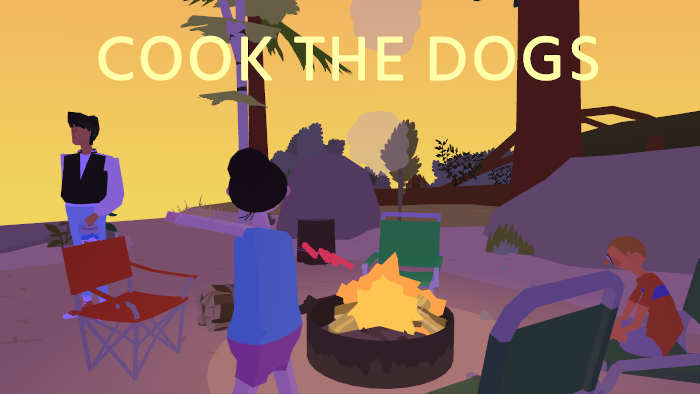
No camping trip would be complete without a campfire cooking experience. (Credit: Turnfollow. Fair use.)
It turns out that Ben and Mord are dating, and their burgeoning relationship is contrasted with Brad and Cloanne’s childless marriage. The story doesn’t build towards some dramatic conclusion or revelation—it is meant to be a “slice of life” in the moments of these characters. There’s relationship talk, birdwatching, and trashy literature.
The game succeeds at bringing Mord, Ben, Brad, and Cloanne to life in the hour or so we spend with them. It’s not a perfect experience: the writing could have used some copyediting, and the game world is so tiny as to feel limiting. The regular price of $8 is a bit high for this charming but very short journey; if you already own it thanks to The Bundle or can get it for less, I definitely recommend the trip.
The game makes you a literal Social Justice Warrior fighting trolls on the internet. The art style and music come together nicely to to feel like an 8 bit adventure game.
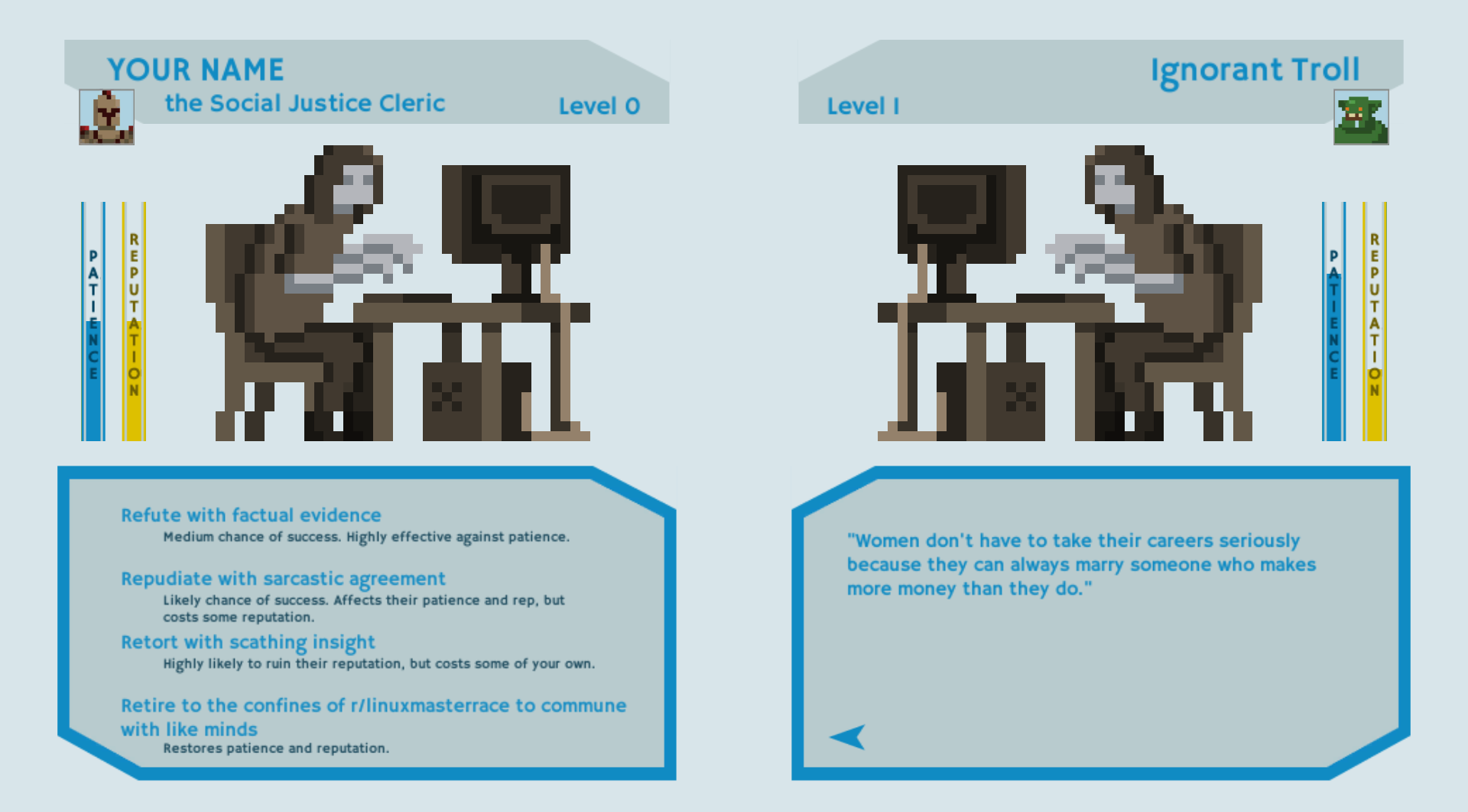
Social Justice Warriors gameplay (Own work. License: CC-BY-SA.)
Gameplay
The game is fairly simple, you choose 1 of 4 characters with unique attacks to fight trolls. Every time you attack, you’ll see lines from the trolls like “Women don’t have to take their careers seriously because they can always marry someone who makes more money than they do”. You fight trolls until someones reputation or patience reaches 0. The game feels fresh for the first 15 minutes until you’ve seen all the troll lines, stooped to using attacks that hurt your reputation and tried all the characters.
Verdict
Game has a cute theme, but gameplay quickly becomes boring. There’s also nothing notable about the message, fighting trolls on the internet is futile wasn’t even insightful in 2014 when the game was released. This game may have worked well as a short video instead.
I’m a big fan of point and click adventures (think The Secret of Monkey Island), a genre that’s frequently been declared dead but that is in fact thriving thanks to crowdfunded major efforts like Broken Age (reviews) and Thimbleweed Park (reviews), smaller studios like Wadjet Eye, and releases by even smaller teams or solo developers. Clam Man is very much the latter, developed by “Team Clam” which appears to comprise three collaborators.
The game is set in a world dominated by anthropomorphic aquatic creatures. You play Clam Man, an ordinary bloke working as a junior sales representative at Snacky Bay Prime Mayonnaise. After Clam Man gets fired for no apparent reason by his crab boss, he begins to uncover a larger mayo-centered conspiracy. Does it go all the way to the top? Mr. Man will try to find out.
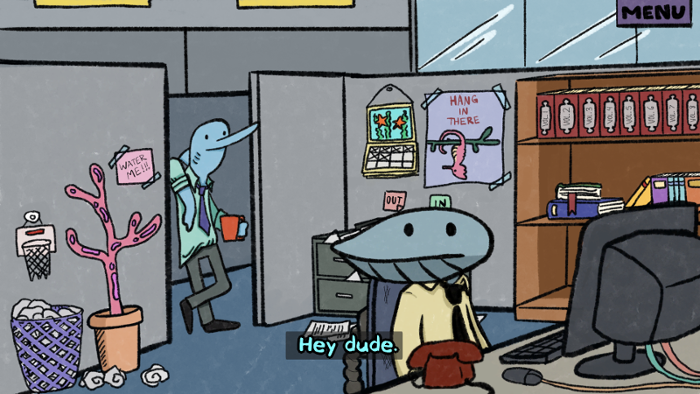
Not all is as it seems at Snacky Bay Prime Mayonnaise. (Credit: Team Clam. Fair use.)
It’s all ridiculous, of course, but some of the jokes are quite funny, and the minimalist hand-drawn art is often very charming. This is only a two hour game, the mouse controls are a bit frustrating, and the writing and artwork don’t quite hold up throughout the short playtime, so the current asking price of $10 is a bit high.
If you already own the game from The Mother of All Bundles, or if you can get it for $5 or less, you’re unlikely to regret your visit to Snacky Bay. Team Clam is certainly one indie developer to keep an eye on.
A depiciton of scenes with minimalist graphics and some objects in places/situations that are out of the ordinary. The only interaction happens at pauses where you are forced to click flashing objects to move to the next segment.
I made it through 3 uninspiring scenes before tapping out. I found the style interesting, but it didn’t go anywhere. The scenes aren’t pretty enough to be appreciated solely for beauty and I found no insight in the places forms were changed from the ordinary.
A Short Hike lets you explore the colorful, pixelated world of Hawk Peak Provincial Park in the role of a vacationing anthropomorphic bird named Claire. Your mission, should you choose to accept it, is to make it to the top of Hawk Peak, ostensibly in search of cell phone reception.
As you make your way through the park, you meet a diverse cast of animal characters. Some offer you side quests, others are simply pursuing their own adventures in the park. It’s up to you whether you want to accept any of these quests, but if you want to make it to the peak, you’ll need to at least obtain a few golden feathers, which allow you to climb the distance.
The game doesn’t end after you reach the peak. There are treasures to be found, hats to be purchased, fish to be caught, and co-operative games of beachstickball to be played. And it’s fun to explore. In spite of the intentionally low resolution graphics, when you sky-dive from the top of a hill, A Short Hike manages to convey a real sense of velocity and freedom.

You can fly, dive, swim, climb, walk, and run. (Credit: Adam Robinson-Yu. Fair use.)
You can’t die in this world, or screw up in any irreversible way. Nor does the game offer the endless grind of more complex farming, fishing, and crafting games. You can rush through the game, or spend a few hours with it, but after that, you’ll likely be done with it—at least until you feel like paying another visit to the park.
If you’re looking for a game to challenge your reflexes or your logic, this ain’t it. But if you just want to chill in a beautiful setting, it’s a perfect pick-me-up.
A Normal Lost Phone (reviews) by Accidental Queens allowed the player to explore a simulated smartphone to discover what happened to its owner, an 18-year-old named Sam. Another Lost Phone uses the same idea to explore different themes. This time, the phone in question belongs to a woman named Laura, who has apparently gone missing.
SMS messages reveal that her boyfriend, Ben, is deeply concerned about her disappearance—but some of his earlier messages suggest a controlling personality, hinting at another story to be uncovered.
The story is told through messages, photos, emails, calendar entries, and notes, many of which are only accessible until you’ve figured out a password or PIN number through various clues. Most of these puzzles are pretty easy, but if you find yourself getting stuck, the excellent Steam Guide will help you to advance without any spoilers.

The first messages we see are from Laura’s boyfriend Ben, expressing deep concern about her disappearance. (Credit: Accidental Queens. Fair use.)
Like the first game, Another Lost Phone explores sensitive social topics with appropriate care, if you can get past the inherently voyeuristic storytelling device of exploring a stranger’s phone.
The game feels a bit more polished than A Normal Lost Phone, with a more engaging story, where all the different pieces (messages and clues) click together really well. Each game tells its own independent story, and if you’re unsure which one to try first, I recommend this one. My playtime was about 1-2 hours.
Gladiabots is a strategy game where you program a team of robots to win battles. There is 3 different game modes, elimination, domination and collection. The single player is lengthy with many levels of increasing difficulty with the layout of the arena and enemy team varying enough to keep it interesting.
The gameplay is half programming, half watching your team do battle. The programming is easy to get started with as every thing is done visually. You layout commands with the leftmost having the most priority. As you try to make your robots behavior more specific, the visual programming becomes a hinderence and anybody whos written code will be yearning to play the game by actually programming. Watching the battles stays fairly entertaining since you can speed up or slow down to only watch the parts that show if your programming is working.
There’s definitely bugs where the game doesn’t execute the programming properly, but they’re rare enough not to impact gameplay. The game also wants you to sign into an account to share your score and will ask you to sign in after EVERY game if you don’t. The game also comes with data collection for the Unreal engine turned on. On Linux, you can see the settings in .config/unity3d/GFX47/Gladiabots/prefs. There was no notice about this either. I only happened to find it while trying to debug a bad build of the game.
<pref name="data.analyticsEnabled" type="int">1</pref>
<pref name="data.deviceStatsEnabled" type="int">1</pref>
<pref name="data.limitUserTracking" type="int">0</pref>
<pref name="data.optOut" type="int">0</pref>
<pref name="data.performanceReportingEnabled" type="int">1</pref>
<pref name="unity.cloud_userid" type="string">ZGVlOTlkNDBhYzc0NzQzNGE5NThiN2JhOThiMGYyZDk=</pref>
<pref name="unity.player_session_count" type="string">MTE=</pref>
<pref name="unity.player_sessionid" type="string">MTYxNTUyNjIwOTAyNzUzOTA3OQ==</pref>
Unplayed: Multiplayer, Collection Mode
Overall, its worth a play.
Your Future Self is an interactive story developed by Contortionist Games, which as of this writing is one developer, Andrew Hirst, based in Sheffield, UK. The game presents itself in a CRT aesthetic with many flicker effects, similar to Pony Island.
The premise is that you’re stuck in a time looping bubble with your future self and have to convince them not to commit an act that will kill thousands of people, but which your future self clearly considered justifiable. Every dialog choice can succeed or fail. If you ultimately don’t succeed, the loop starts again.
As you pick from different strategies to engage with “yourself”, the story unfolds. You can’t pick the exact words you want to say to yourself—your choices are always to be rational, empathetic, or assertive, and the game decides what that means in a given context.
There’s a light RPG-like mechanic at play here, where your “skill” at being rational, empathetic, or assertive is measured against your future self’s skills and receptivity in those areas. If you turned on “helper mode” on the start screen, the game shows you the likelihood that a given choice will succeed.
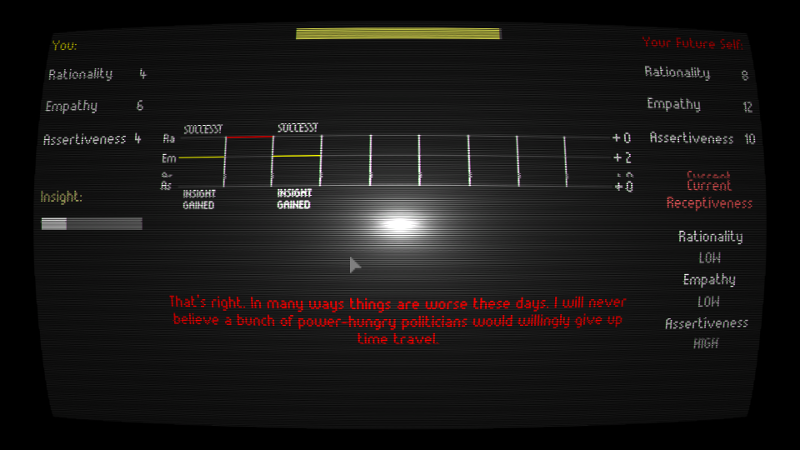
The success or failure of your attempts to persuade your future self is visualized, and is subject to a simple RPG-like mechanic. The CRT scanline effect, curved screen, and center glare are in-game visuals. (Credit: Contortionist Games. Fair use.)
There are, of course, additional layers to the story, and the game employs intense visual effects to keep things interesting. It also has an excellent chiptune soundtrack. Check out Rebels to the Rescue and Your Future Self (Remix).
The time loop mechanic can get a bit tedious if you have to click through the same loop a couple of times to find the right answers—in retrospect I think I would have enjoyed the game more if I had enabled “Helper mode”. The story was interesting enough to keep me engaged until the ending (I think I played for about 1-2 hours).
I’d give it 4 stars—the game mechanics and story aren’t perfect, but the excellent soundtrack and atmosphere make up for most of the game’s weaknesses.
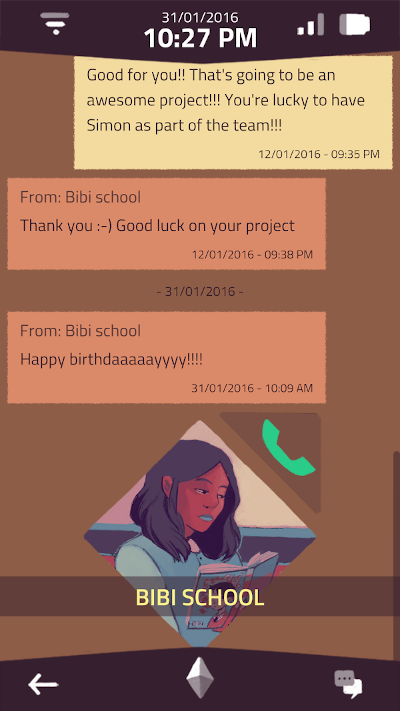
You get to browse websites, read IMs and emails and explore apps, all of which reveal layers of the game’s story. (Credit: Accidental Queens / Dear Villagers. Fair use.) Many games incorporate phones you can interact with into the game; in A Normal Lost Phone, the phone is the game. With little introduction, you get to snoop around the apps and messages stored in a lost phone that supposedly belongs to a kid named Sam who just celebrated their 18th birthday.
You discover who Sam appears to be to their friends and family; as you peel away layers of clues (“which number is the password to this app?”), you also discover new layers to Sam’s story. The story is engaging and handles mature themes of tolerance and identity well, but it is a bit predictable. It’s a short game (1-3 hours, depending on how much time you spend reading every bit of flavor text).
There’s some great artwork to discover, and a nice soundtrack that’s accessible through the phone’s music player.
It’s hard to categorize A Normal Lost Phone, but if you enjoy story-based games like Gone Home that progress quickly with very light puzzles, there’s a good chance you’ll enjoy this one, too. 3.5 stars, rated up because of the high quality art and music and the smooth interface.